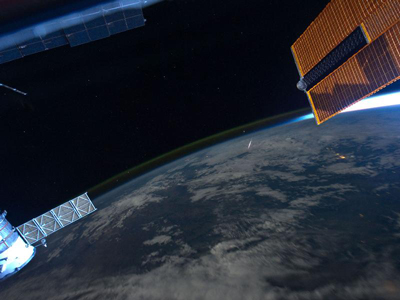A multicolored Perseid meteor viewed in the sky just to the right from Milky Way in August 2007. Image via Wikimedia Commons
Prepare to be dazzled by meteors streaking across the sky on the nights of 11-12 August, as the annual Perseid meteor shower is set to peak this weekend as a result of trailing debris from the Swift-Tuttle comet, which was first discovered 150 years ago.
Two US astronomers who had been working independently of each other – Lewis Swift and Horace Tuttle – first observed the comet in July 1862. That’s why it gets its name Swift-Tuttle.
In 1867 Italian astronomer Giovanni Schiaparelli announced that the orbit of the comet Swift-Tuttle appeared to leave debris in its orbit. The earth observes this debris – small fragments that break away from the comet and hurl through space – as the Perseid meteor shower.
The comet itself orbits the sun every 130 years. Because of the path of the Swift-Tuttle’s orbit, Perseid meteors showers are generally best seen in the northern hemisphere, so astronomers in Australia, New Zealand, and portions of South America might not get the best views of the shooting stars.

What a shooting start looks like from space … last August astronaut Ron Garan, Expedition 28 flight engineer, tweeted this image from the International Space Station, along with this caption: “What a ‘Shooting Star’ looks like from space, taken yesterday during Perseid Meteor Shower”. Image by NASA
According to the International Meteor Organization (IMO), the maximum of the Perseids this year will fall into a period between 12pm and 2.30pm (UT) on 12 August and the waning crescent moon is not expected to be a major obstacle.
The IMO has indicated that the moon will rise from mid-northern locations around local midnight to brightness to 1am. It said that the moon’s “relative proximity” to the Perseid radiant should be considered more of a “nuisance” than a deterrent.
Mid-northern latitudes are also set to get the best observations of the meteor showers. From Ireland, the IMO said people will be able to observe the shower’s radiant from 10-11pm local time onwards.
The American Meteor Society is claiming that the evening of 12 August may provide up to 10 Perseids per hour. At their peak, one can see between 30 and 50 Perseid meteor showers per hour, which burn up in the Earth’s atmosphere, flaring as they go, having travelled at 212,433 kilometres per second.
It seems that human beings have been observing such Perseid meteor showers for around 2,000 years. Let’s hope this year will prove to be spectacular!